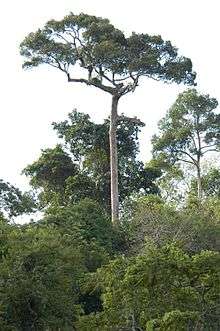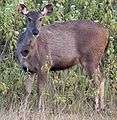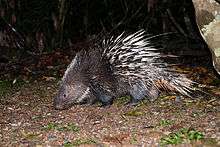Khao Yai National Park
| Khao Yai National Park | |
|---|---|
|
IUCN category II (national park) | |
|
Heo Suwat waterfall | |
 | |
| Location | Thailand |
| Nearest city | Pak Chong |
| Coordinates | 14°26′29″N 101°22′11″E / 14.44139°N 101.36972°ECoordinates: 14°26′29″N 101°22′11″E / 14.44139°N 101.36972°E |
| Area | 2,168 km² |
| Established | 1962 |
| Visitors | 828,525 (3 Apr 2014) |
| Governing body | Department of National Parks, Wildlife and Plant Conservation |

Khao Yai National Park (Thai: เขาใหญ่, pronounced [kʰǎw jàj]) is a national park in Thailand.
Description
Khao Yai National Park is in the western part of the Sankamphaeng Mountain Range, at the southwestern boundary of the Khorat Plateau. The highest mountain in the area of the park is 1,351 m high Khao Rom.
This park lies largely in Nakhon Ratchasima Province (Khorat), but also includes parts of Saraburi, Prachinburi, and Nakhon Nayok Provinces.
The park is the third largest in Thailand. It covers an area of 300 square kilometers, including tropical seasonal forests and grasslands. Its altitude mostly ranges from 400–1,000 m above sea level. There are 3,000 species of plants, 320 species of birds like red junglefowl and coral-billed ground cuckoo, and 66 species of mammals, including Asian black bear, Indian elephant, gaur, gibbon, Indian sambar deer, pig-tailed macaque, Indian muntjac, Ussuri dhole, and wild pig. Although evidence of tiger presence has not been recorded recently, monitoring by Freeland Foundation in collaboration with Department of National Park rangers has discovered tigers (the Indochinese tiger subspecies) in other parts of eastern Thailand where they were previously thought to have been completely extirpated.[1] Its waterfalls include the 80 metre Heo Narok, and Heo Suwat made famous from the film The Beach. Namtok Sarika is popular with the Thais.
Recent wildlife studies show that animal ranges, particularly the few resident tigers, are impacted by human activity near the center of the park. This study has not deflected the government's call for private lodging concessions within the park itself.
History
Around 1922 some people from Ban Tha Dan and Ban Tha Chai villages in Nakhon Nayok Province built a settlement within the forest in the Sankamphaeng mountains. Up to 30 households cultivated the land. The area was formally recognized by the government and classified as Tambon Khao Yai within Pak Phli District.
However, due to its remoteness from the authorities it became a refuge for criminals and fugitives. After an attempt to capture the suspects in the area, in 1932 the villagers were relocated into the plains some 30 km away and the tambon status was cancelled.
In 1959 the prime minister, Field Marshal Sarit Thanarat, instructed the Ministry of Agriculture and the Ministry of the Interior to create a process whereby national parks could be established.
Khao Yai National Park was then established on September 18, 1962, declared by royal proclamation in the Government Gazette (Book 79, Section 89) as the first national park in Thailand. A major role in its establishment was played by Boonsong Lekakul, one of the 20th century's most famous Thai conservationists. It was named after the defunct tambon, Khao Yai.
In 1984 the park was made an ASEAN Heritage Park, and on July 14, 2005 the park, together with other parks in the same range and in the Dong Phaya Yen Mountains further north, was proclaimed a UNESCO World Heritage Site under the name "Dong Phaya Yen–Khao Yai Forest Complex". As the lands adjacent to the national park are becoming increasingly developed into luxury hotels and golf courses, acquiring land for future wildlife conservation efforts is becoming problematic. Homes and residential villas have been built illegally within the limits of the protected area of the forest.[2] Illegal logging is also a problem in the area of the park.[3]
Climate

Khao Yai National Park has three main seasons, with an annual mean temperature of 23° Celsius, though this varies greatly with the seasons.
- Rainy season (May–October): Most days have high rates of precipitation. The atmosphere is humid with average temperatures of 27 °C during the day dropping to 13 °C at night. Streams at peak flow.
- Cold season (November–February): Clear skies, sunny and cool. Average temperatures of 22 °C during the day and 10 °C at night. Good time for hiking.
- Hot season (March–April): Humid with daytime temperatures of 20–30 °C and 17 °C at night.
Geology

Limestone is present towards the eastern end close to the Dângrêk Mountains. Sandstone outcrops exist in the south and north of the park. Shales and schist are also present. In the south, steep slopes made of granite and conglomerates are seen.
Drainage
There are four drainage areas in the park which are vital catchments for four river systems. The Takhong River drains from the central Khao Yai area and runs in a northeasterly direction to the Mekong. The Sai Yai system drains from the eastern basin, turning sharply into the southern floodplains and on to the Gulf of Thailand. The Nakhon Nayok river system drains from the southwest watershed into Nakhon Nayok Province to the south. The Saraburi Province drainage system drains westward from the far west of Khao Yai.
Fauna
Khao Yai is home to a variety of animals. It is one of the few places in Thailand where wild elephants still survive. They are regularly seen and are a major tourist attraction. Other larger animals include gibbons, pig-tailed macaques, muntjacs and sambar deer.
 Asiatic elephant, Khao Yai
Asiatic elephant, Khao Yai- Wild elephants
 A herd of elephants walking up a road in the Park area
A herd of elephants walking up a road in the Park area


 Northern pig-tailed macaque (Macaca leonina)
Northern pig-tailed macaque (Macaca leonina)




 Orange-headed thrush (Geokichla citrina)
Orange-headed thrush (Geokichla citrina)
 Malayan porcupine, Khao Yai National Park
Malayan porcupine, Khao Yai National Park_-_Khao_Yai_National_Park_01.jpg) A juvenile Trimeresurus vogeli (Vogel's Pit Viper)
A juvenile Trimeresurus vogeli (Vogel's Pit Viper)
Services
The park is often visited by travelers from Isan, Bangkok and beyond. There are per-day fees for visitors and vehicles., with concessions for Thais or Thai residents.
- Food is available from private concessions within the park.
- Kayaking and rafting services are available in Prachinburi, in the far southeast of the park.
- Night-time "wildlife spotlighting" is available via pick-up trucks in the early evening. Possible animal sightings include deer, civets, nightjars, porcupines, and occasionally even elephants or other more rare nocturnal creatures.
- Slide shows at the visitor center are available on weekends and public holidays.
- Meeting rooms are available with audiovisual equipment for seminars and workshops.
- Camping is permitted in camping zones.
- Lodges and cabins are available for singles and groups. Reservations are required.
Attractions

- There are over 50 km of hiking trails. From easy to hard, one hour to three days. The trails on the map from the visitors center will only have the easier trails. Maps do come with English instructions. A guide is recommended for most trails if the tourist has no experience.
- Kayaking and rafting.
- Night time wildlife spotlighting.
- Observation towers at Nong Pak Chee or Mo Sing. Early morning is the best time to view the Great hornbills, gaur, and sometimes elephants. Gibbons are most active in the early morning.
- At about 17:30 thousands of wrinkled lipped bats emerge from a cave 3 km outside the northern gate to begin night time feeding. The bats fly in a ribbon pattern across the sky.
- Klong Pa Kang-Wang Haew-Dinosaur Footprint. Four-day trek to see a dinosaur footprint.
Waterfalls
- Heo Narok Waterfall - The Haew Narok waterfalls are the largest waterfalls in the park. It is a three-tiered structure that extends 150 meters from the top tier to the basal lake. The waterfall is located about 10 kilometers from the south gate along the central road through Khao Yai.
- Heo Suwat Waterfalls - This waterfall runs over a 20-meter cliff into a large pool below. It is located about 8 km to the east of the visitors center and can be visited easily by car along one of the main easterly roads. It can also be reached by an 8 km hike from the visitor center (walk number 4) which takes about 4–7 hours. It is made up mainly of multiple layers of sandstone conglomerates with large interbeds of basalt.
- Heo Sai Waterfalls - Haew Sai Waterfalls are located 700 meters north of the Haew Suwat Waterfalls. It is 8 km east of the visitor centre and can also be reached via car or hiking.
- Heo Prathun Waterfalls - Smaller waterfall that is about 1 km north of Haew Sai waterfall.
See also
| Wikimedia Commons has media related to Khao Yai National Park. |
- Dong Phayayen - Khao Yai Forest Complex
- Sankamphaeng Range
References
External links
- National Park Division
 Khao Yai National Park travel guide from Wikivoyage
Khao Yai National Park travel guide from Wikivoyage- Mammals, birds and reptiles of Khao Yai National Park
- thaibirding.com on Khao Yai National Park
- List of Birds of Khao Yai National Park

